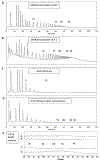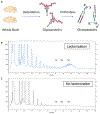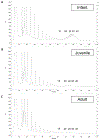Improved methods to characterize the length and quantity of highly unstable PolySialic acids subject category: (Carbohydrates, chromatographic techniques)
- PMID: 34687617
- PMCID: PMC9121810
- DOI: 10.1016/j.ab.2021.114426
Improved methods to characterize the length and quantity of highly unstable PolySialic acids subject category: (Carbohydrates, chromatographic techniques)
Abstract
Polysialic acid (polySia) is a linear homopolymer of α2-8-linked sialic acids that is highly expressed during early stages of mammalian brain development and modulates a multitude of cellular functions. While degree of polymerization (DP) can affect such functions, currently available methods do not accurately characterize this parameter, because of the instability of the polymer. We developed two improved methods to characterize the DP and total polySia content in biological samples. PolySia chains with exposed reducing termini can be derivatized with DMB for subsequent HPLC analysis. However, application to biological samples of polySia-glycoproteins requires release of polySia chains from the underlying glycan, which is difficult to achieve without concurrent partial hydrolysis of the α2-8-linkages of the polySia chain, affecting its accurate characterization. We report an approach to protect internal α2-8sia linkages of long polySia chains, using previously known esterification conditions that generate stable polylactone structures. Such polylactonized molecules are more stable during acid hydrolysis release and acidic DMB derivatization. Additionally, we used the highly specific Endoneuraminidase-NF enzyme to discriminate polysialic acid and other sialic acid and developed an approach to precisely measure the total content of polySia in a biological sample. These two methods provide improved quantification and characterization of polySia.
Keywords: DMB derivatization; Degree of polymerization; Lactonization; Polysialic acid.
Copyright © 2021. Published by Elsevier Inc.
Figures





Similar articles
-
Charged aerosol detector HPLC as a characterization and quantification application of biopharmaceutically relevant polysialic acid from E. coli K1.J Chromatogr A. 2019 Aug 16;1599:85-94. doi: 10.1016/j.chroma.2019.03.069. Epub 2019 Apr 1. J Chromatogr A. 2019. PMID: 30961966
-
Degree of polymerization (DP) of polysialic acid (polySia) on neural cell adhesion molecules (N-CAMS): development and application of a new strategy to accurately determine the DP of polySia chains on N-CAMS.J Biol Chem. 2005 Nov 18;280(46):38305-16. doi: 10.1074/jbc.M508762200. Epub 2005 Sep 19. J Biol Chem. 2005. PMID: 16172115
-
Determination of the Structural Integrity and Stability of Polysialic Acid during Alkaline and Thermal Treatment.Molecules. 2019 Dec 31;25(1):165. doi: 10.3390/molecules25010165. Molecules. 2019. PMID: 31906121 Free PMC article.
-
Disialic, oligosialic and polysialic acids: distribution, functions and related disease.J Biochem. 2013 Aug;154(2):115-36. doi: 10.1093/jb/mvt057. Epub 2013 Jun 20. J Biochem. 2013. PMID: 23788662 Review.
-
Polysialic acid: biosynthesis, novel functions and applications.Crit Rev Biochem Mol Biol. 2014 Nov-Dec;49(6):498-532. doi: 10.3109/10409238.2014.976606. Epub 2014 Nov 6. Crit Rev Biochem Mol Biol. 2014. PMID: 25373518 Review.
Cited by
-
Salmonid polysialyltransferases to generate a variety of sialic acid polymers.Sci Rep. 2023 Sep 20;13(1):15610. doi: 10.1038/s41598-023-42095-0. Sci Rep. 2023. PMID: 37730806 Free PMC article.
-
Polysialic acid is upregulated on activated immune cells and negatively regulates anticancer immune activity.Front Oncol. 2025 Mar 20;15:1520948. doi: 10.3389/fonc.2025.1520948. eCollection 2025. Front Oncol. 2025. PMID: 40182033 Free PMC article.
References
Publication types
MeSH terms
Substances
Grants and funding
LinkOut - more resources
Full Text Sources

